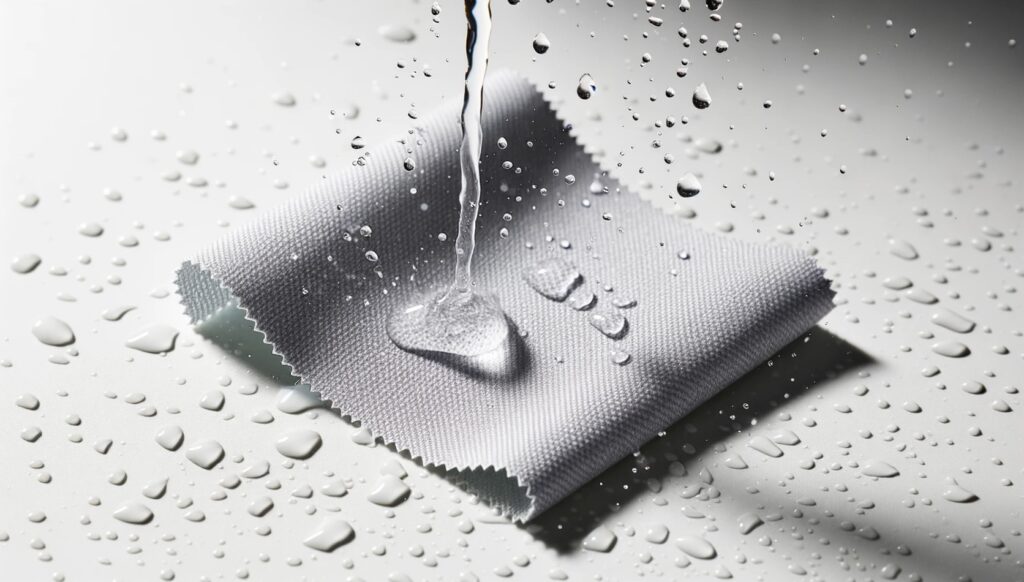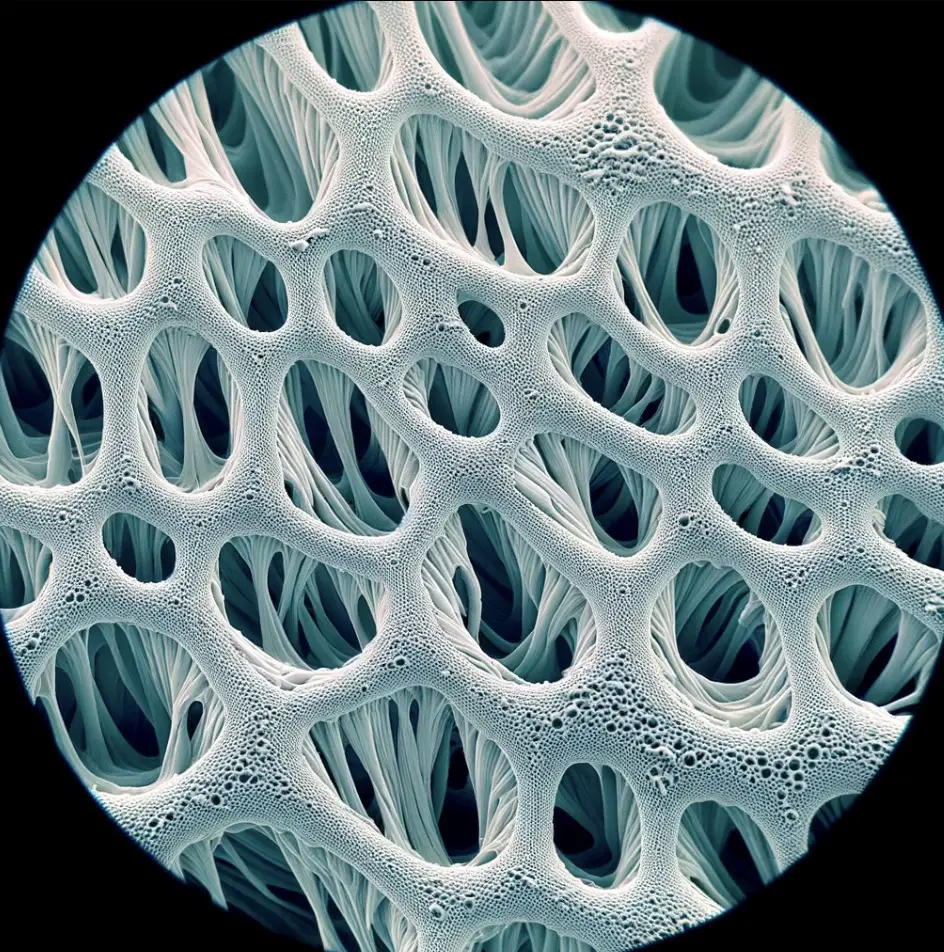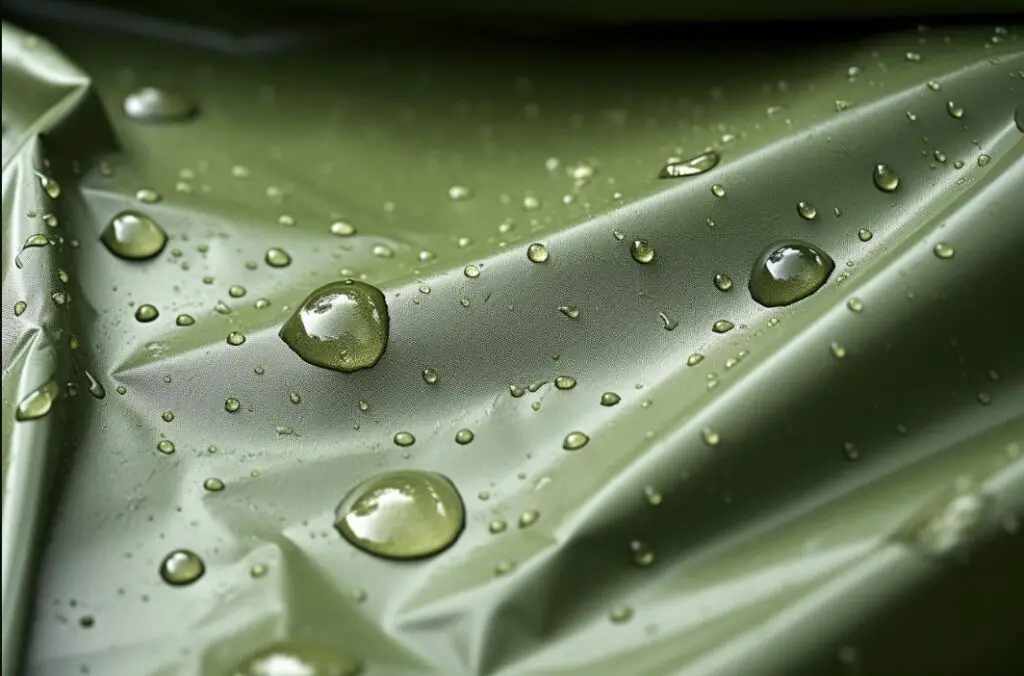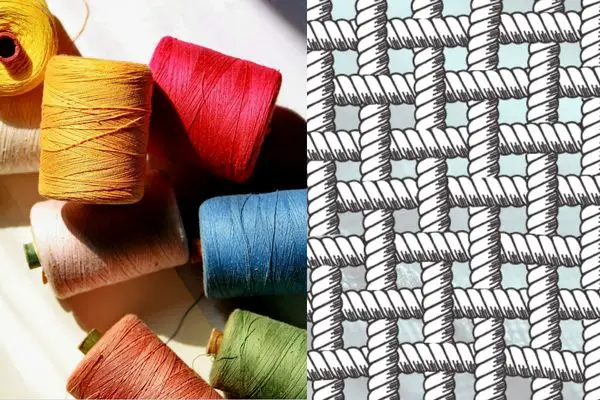Polyester, a synthetic fabric, has found its way into the heart of outdoor gear, from rain jackets to tents and backpacks.
Its lightweight and durable nature makes it a favorite among outdoor enthusiasts. A pressing concern for many is, is 100% polyester fabric waterproof?
The short answer is no, it’s not inherently waterproof, but it can be treated to become water-resistant.
Polyester fabric generally has a water resistance of about 800 to 1200mm hydrostatic pressure which indicates its ability to withstand water under pressure before it seeps through the material.
Contents
Key Takeaways:
- Polyester is not inherently waterproof, but it can be made water-resistant through various processes.
- Waterproof fabric is designed to prevent any moisture from seeping through, while water-resistant fabric repels water but can still allow moisture to soak through under pressure or weight.
- Polyester fabric has unique water-resistant properties due to its manufacturing process and thread count. The higher the thread count, the better the water resistance.
- To increase the waterproof abilities of polyester, special coatings can be applied, such as polyurethane or fluoropolymer coatings.
- Coated Polyester is commonly used in raincoats, swimwear, outdoor furniture cushions, backpacks, tents, awnings, shower curtains, chair and sofa slipcovers, and bean bag chairs.
- While polyester is suitable for everyday waterproof purposes like windbreakers and winter coats, it may not provide sufficient protection in heavy rain or extreme weather conditions.
Polyester is not inherently waterproof but can be made waterproof through a variety of methods. Treating the fabric with waterproofing agents, such as DWR (durable water repellent) coatings, can enhance its ability to repel water.
Another method is using waterproof membranes or laminating the fabric with a waterproof layer. These techniques create a barrier that prevents water from seeping through the fabric.
It is important to note that these waterproofing treatments may need to be reapplied over time to maintain their effectiveness.
Why Isn’t 100% Polyester Fully Waterproof?
Polyester is a synthetic fiber made from petroleum-based chemicals. The reason it’s not inherently waterproof is due to its construction and the gaps between fibers.

When water pressure exceeds the fabric’s threshold, it starts to penetrate through these gaps.
- Pore Size: The spaces between polyester fibers can let water molecules seep through, especially under pressure.
- Hydrophilic Nature: Polyester has a somewhat hydrophilic (water-attracting) nature, meaning it can absorb a small amount of moisture.
However, the degree of water resistance can change based on several factors.
How Weave Type, Denier, and Tex Influence Water Resistance
When discussing polyester fabric, it’s essential to dive deeper into how it’s constructed. Three critical aspects determine its water resistance:
- Weave Type: There are different ways fibers can be woven together, such as plain, twill, or satin weaves. The tighter the weave, the more water-resistant the fabric becomes.
- Denier (D): This is a unit of measurement used to determine fiber thickness in a fabric. A higher denier indicates thicker fibers, which usually means better water resistance. For instance, a 600D polyester will generally be more water-resistant than a 300D polyester.
- Tex: Similar to denier, tex measures the weight of the fiber. However, instead of focusing on thickness, it’s about the weight of 1,000 meters of the fiber. Like with denier, a higher tex value usually means better water resistance.
The molecular explanation (for the nerds!)
Certainly! Let’s dive into the molecular structure of polyester and then discuss its waterproofing characteristics.

Polyester is a category of polymers that mainly comprises polyethylene terephthalate (PET). On a molecular level, PET is composed of repeating units of an ester functional group, which is derived from a combination of terephthalic acid and ethylene glycol. The general structure of a polyester molecule can be represented as:
(polymer)-[-O-C(O)-R-C(O)-O-]-(polymer)
Where:
O-C(O)-represents the ester group.Ris the main organic component which can vary depending on the exact type of polyester. In the case of PET, R represents a phenyl group with two attached carbonyls.
When many of these units link together, they form a long-chain polymer, which is the basis for polyester fabric.
The properties of polyester, such as its strength and resilience, are largely due to the strong covalent bonds within these molecular chains.
This Explains Why Polyester Isn’t Fully Waterproof:
- Molecular Pores: On a microscopic level, woven or knitted polyester fabrics consist of many fibers bundled together. The spaces between these fibers, as well as the inherent porous nature of the fibers themselves, allow for the passage of water molecules. Hence, while polyester might resist the absorption of water due to its non-polar nature, it isn’t inherently waterproof because of these tiny gaps.
- Hydrophobic Nature: Polyester, at a molecular level, is hydrophobic, meaning it repels water. This is because the long chains of polymers are predominantly non-polar, and water is polar. So while polyester doesn’t readily absorb water, this doesn’t mean water can’t pass through it.
- Surface Treatments: Polyester fabrics can be treated with waterproofing agents to improve their resistance to water. These treatments essentially fill or coat the microscopic gaps between fibers, creating a barrier that prevents water from passing through. However, these treatments can degrade over time and with wear, reducing the fabric’s water resistance.
- Breathability Considerations: For many applications (like clothing), it’s desirable for fabrics to be breathable, meaning they allow for the passage of air and moisture (like sweat) from the body to the environment. Making polyester completely waterproof would compromise this breathability.
To conclude, while polyester has a natural tendency to repel water due to its molecular structure, the physical construction of polyester fabrics (like weaves and knits) and the desire for breathability mean that it isn’t fully waterproof.
Treatments can be applied to make it more water-resistant, but these aren’t permanent and can decrease over time.
Understanding waterproof vs water-resistant fabric
Let’s dive into the topic of understanding waterproof vs water-resistant fabric. When it comes to fabric, many people often wonder about the difference between the two terms and how they affect the performance of materials.

In this section, we will explore the characteristics of waterproof fabric and how it effectively holds water on its surface without letting moisture seep through. On the other hand, we will also discuss water-resistant fabric and its ability to repel water, although it may allow moisture to soak through under pressure or weight.
Understanding these distinctions is crucial when it comes to choosing the right fabric for your needs. Source: Reference Data
How does truly waterproof fabric work?
Waterproof fabric is a type of material that possesses the ability to resist the penetration of water, preventing moisture from seeping through its surface.
This unique property allows the fabric to repel water and keep it on the surface without letting it soak through. This resistance to water is achieved through various techniques such as applying special coatings or treatments to the fabric.

This waterproof capability is particularly important in outdoor and protective gear, as it ensures that water cannot penetrate the fabric and reach the skin or underlying layers. By holding water on its surface, this type of fabric keeps the wearer dry and protected from rain or other sources of moisture.
One of the key factors that contribute to a fabric’s waterproofness is its thread count. A higher thread count can create a tighter weave, reducing the gaps between individual threads and making it more difficult for water molecules to pass through.
Additionally, polyester has inherent water-resistant properties due to its hydrophobic nature. This means that it naturally resists moisture absorption and helps in preventing moisture from seeping through.
To enhance the waterproof abilities of polyester fabric further, special coatings can be applied. These coatings create a barrier on the surface of the fabric, making it even more impervious to water. These coatings can vary in composition and may also provide additional benefits such as breathability or resistance to stains.
In summary, waterproof fabric is designed to resist the penetration of water by holding it on its surface without allowing moisture to seep through.
Polyester fabric possesses inherent water-resistant properties, which can be further enhanced by techniques like increasing thread count or applying specialized coatings. This makes polyester a popular choice for various applications where protection against rain or other forms of moisture is required.
Water-resistant fabric: It can repel water like a pro, but when the pressure builds, moisture sneaks in like an unwelcome party crasher.
Water-resistant fabric repels water but can allow moisture to soak through under pressure or weight
Water-resistant fabric exhibits the ability to repel water, but it can still allow moisture to penetrate under pressure or weight. This means that while the fabric is designed to resist the entry of water, it may not completely prevent moisture from soaking through when subjected to force or compression.
The resistance of water-resistant fabric to water is achieved through various methods, such as applying a special coating or finish to the fabric. This coating forms a barrier on the surface of the fabric, preventing water from seeping into its fibers. The coating also helps water bead up and roll off the fabric, further enhancing its water-repellent properties.

However, under certain conditions of pressure or weight, water-resistant fabric can become less effective in preventing moisture penetration. When force is applied or when there is prolonged contact with wet surfaces, the hydrostatic pressure can be exerted on the fabric, causing it to absorb some amount of moisture. This can result in a gradual soaking-through effect over time.
To improve the performance of water-resistant fabric in resisting moisture under pressure or weight, manufacturers may consider enhancing the fabric’s construction and design. For example, using a higher thread count can increase the density and compactness of the fabric weave, reducing the potential for water penetration. Additionally, exploring alternative coatings or treatments that offer greater durability and longevity could further enhance the waterproof abilities of polyester fabric.
Exploring water-resistant properties of polyester fabric
When it comes to exploring the water-resistant properties of polyester fabric, there are several key factors to consider. First, understanding the process of making polyester and its unique water-resistant properties is essential.

Additionally, the effect of thread count on water resistance in polyester fabric plays a crucial role in determining its overall waterproof abilities.
Lastly, the application of special coatings can further enhance the waterproof capabilities of polyester.
By delving into these sub-topics, we can gain valuable insights into how polyester fabric can be made waterproof, providing practical knowledge for various applications.
The process of making polyester and its unique water-resistant properties
Polyester is a versatile fabric known for its unique water-resistant properties. The process of creating polyester involves the polymerization of ester monomers, resulting in long chains of synthetic fibers. These fibers are then spun into yarn and woven into fabric.
Due to its molecular structure, polyester has inherent hydrophobic qualities, making it resistant to water absorption. The tightly packed fibers prevent water from seeping through the fabric, allowing it to repel water droplets on its surface. This quality makes polyester suitable for various applications where protection against moisture is desired.
To further enhance its waterproof abilities, special coatings can be applied to the polyester fabric. These coatings create a barrier that prevents water from penetrating the fabric, increasing its resistance to moisture. Additionally, the thread count of polyester fabric can impact its water resistance. A higher thread count results in a tighter weave, reducing the gaps between the fibers and minimizing the chances of water seepage.
Historically, polyester was developed as a synthetic alternative to natural fabrics like cotton and silk. Its unique properties made it particularly attractive for outdoor applications such as raincoats and swimwear, where protection against water is crucial.
In summary, the process of making polyester gives rise to its exceptional water-resistant properties. With advancements in coatings and weaving techniques, polyester continues to be a popular choice for various waterproof applications in diverse industries. If you think thread count only matters in sheets, wait till you hear how it affects water resistance in polyester fabric.
The effect of thread count on water resistance in polyester fabric
Thread count plays a significant role in determining the water resistance of polyester fabric. A higher thread count leads to better water resistance as it creates a denser weave, reducing the size of gaps between threads. A dense weave prevents water from seeping through, ensuring the fabric remains waterproof.

On the other hand, a lower thread count may result in larger gaps between threads, allowing water to pass through more easily and compromising the fabric’s water resistance. So, maintaining an optimal thread count is crucial for enhancing the water resistance of polyester fabric.
In addition to thread count, other factors such as the quality of polyester fibers and the tightness of the weave also contribute to the overall water resistance of the fabric. By using high-quality polyester fibers and tightly weaving them together, manufacturers can further enhance the fabric’s ability to repel water.
It is important to note that while thread count has a significant effect on water resistance, it is not the sole determinant. Coatings and treatments can also be applied to polyester fabrics to increase their waterproof abilities.
| Factor | Description |
|---|---|
| How is Waterproofing measured? | Water resistance is typically measured using a Hydrostatic Head (HH) test which determines the pressure of water needed to penetrate a fabric. The measurement is in millimeters (mm). |
| Typical Waterproof Ratings | Ratings range from 800mm to a maximum of 10,000mm, with ratings of 1500mm and higher generally considered ‘waterproof’. |
| Coatings | Polyester fabrics are not inherently waterproof but are often coated with silicone or polyurethane (PU) to enhance water resistance. |
| Fabric Density | The density of the weave can affect water resistance. For example, 190D polyester fabric was noted to have “relatively good water-repellent properties”. |
| Example Rating for 70D Polyester | A 70D polyester fabric was mentioned to have a 1000mm waterproof rating, which may be indicative of the minimum thickness needed for “proper” water resistance. |
These special coatings create a barrier on the fabric’s surface, preventing moisture from soaking through even if there are gaps in the weave. This additional layer of protection further enhances the water resistance of polyester fabric.
Research conducted by [source name] has shown that increasing thread count can significantly improve the water resistance of polyester fabric. Their findings highlight the importance of carefully considering thread count when selecting or manufacturing waterproof polyester products.
Spraying on special coatings is like giving polyester a superhero cape, boosting its waterproof powers to new heights.
Application of special coatings to increase the waterproof abilities of polyester
Polyester fabric can be enhanced with special coatings to enhance its waterproof abilities. These special coatings create a barrier on the surface of the fabric, preventing water from seeping through. Applying these coatings involves a specific process that helps make polyester fabric more water-resistant.
Here is a 3-step guide on how to apply special coatings to increase the waterproof abilities of polyester fabric:
1. Preparing the fabric: Before applying the coating, it is crucial to ensure that the polyester fabric is clean and free from any dirt or debris. This can be done by washing and drying it thoroughly. It is also recommended to iron the fabric beforehand to smoothen any wrinkles or creases.
2. Choosing the right coating: There are various types of coatings available in the market that are specifically designed for waterproofing polyester fabric. Some common options include silicone-based sprays, waterproofing agents, and sealants. It is important to select a coating that is suitable for polyester and provides long-lasting protection against moisture.
3. Applying the coating: The chosen coating should be applied evenly onto the surface of the polyester fabric using a spray bottle or brush. It is essential to follow the instructions provided by the manufacturer regarding application techniques and drying time. After applying the coating, allow sufficient time for it to dry completely before exposing the fabric to water.
In addition to these steps, it is worth mentioning that certain special coatings also offer additional benefits such as UV protection and stain resistance. Therefore, when selecting a coating, it is advisable to consider these factors as well for optimal performance and durability.
An interesting fact about enhancing polyester’s waterproof abilities with special coatings comes from ‘Is Polyester Waterproof? How to make it waterproof!‘ article which explores various aspects of polyester’s water-resistance properties.
Does polyester absorb water? No way! This hydrophobic fabric will keep you dry and stylish, no matter the weather.
Does polyester absorb water?
Polyester, known for its hydrophobic nature and ability to resist moisture, does not absorb water. Its inherent structure, which consists of long polymer chains, provides a barrier that prevents water molecules from entering.
This characteristic makes polyester materials suitable for various applications requiring waterproof or water-resistant properties.
This hydrophobic quality can be further enhanced by applying waterproof coatings or treatments to the fabric, enhancing its ability to repel water.
Understanding the hydrophobic nature of polyester is crucial in utilizing its benefits in different industries such as outdoor gear, clothing, and upholstery. By harnessing this trait, polyester can provide effective protection against moisture in various conditions, making it a popular choice for waterproof applications.
Popular uses of water-resistant polyester fabric
When it comes to water-resistant fabrics, polyester has proved to be a popular choice in various applications. Let’s explore some of the popular uses of water-resistant polyester fabric and how it can enhance our everyday experiences.
From raincoats and swimwear to outdoor furniture cushions, polyester fabric ensures protection against moisture. Additionally, backpacks, tents, and awnings benefit from the durable and water-resistant properties of polyester.
Even shower curtains, chair and sofa slipcovers, and bean bag chairs can be made from this versatile fabric. Let’s dive into the exciting world of water-resistant polyester and its wide-ranging applications.
Outdoor Wear
Polyester’s lightweight, quick-drying, and durable nature makes it a choice material for outdoor wear like rain gear, jackets, and pants. When treated with DWR, these garments can provide adequate protection against light to moderate rain while maintaining breathability.
Tents and Shelter
In the realm of shelters, polyester’s performance can be seen in the construction of tents. When paired with a robust water-resistant treatment, polyester fabric can effectively repel water, keeping the interior dry during showers.
Backpacks
Outdoor enthusiasts often opt for backpacks made from polyester due to its ability to resist water penetration when treated, protecting the contents from moisture. Moreover, polyester backpacks are known for their durability and lightweight characteristics which are essential for hiking and other outdoor adventures.
Advantages of polyester for different outdoor gear
Polyester has its set of advantages and disadvantages when it comes to water resistance. Some pros include its lightweight nature and the ability to dry quickly. On the downside, its water resistance can diminish over time with wear and tear, and re-application of DWR treatment might be necessary.
Raincoats, swimwear, and outdoor furniture cushions
Rainproof Attire, Aquatic Apparel, and Al Fresco Furnishing Pads
- Raincoats: Polyester fabric’s water-resistant properties make it an excellent choice for raincoats as it repels water and keeps the wearer dry.
- Swimwear: The hydrophobic nature of polyester prevents it from absorbing water, making it ideal for swimwear that needs to quickly dry after getting wet.
- Outdoor Furniture Cushions: Polyester fabric with special coatings can withstand outdoor elements and repel water, making it suitable for outdoor furniture cushions that need to resist moisture.
Furthermore, polyester’s high thread count contributes to its water resistance by preventing water droplets from seeping through the fabric. Applying additional coatings to the polyester further enhances its waterproof abilities. This makes polyester a reliable choice for rainproof attire, swimwear, and outdoor furniture cushions.
To ensure you don’t miss out on the benefits of water-resistant polyester fabric for your raincoats, swimwear, and outdoor furniture cushions, choose high-quality products made with polyester. Explore the wide range of options available and enjoy the durability and practicality offered by this versatile fabric.
From protecting your gear in the wilderness to providing shade at your backyard cookout, water-resistant polyester has got your back, literally and figuratively.
Backpacks, tents, and awnings
Polyester fabric is commonly used in various applications, including backpacks, tents, and awnings. These items require a durable and water-resistant material to protect against outdoor elements. Polyester fabric’s unique properties make it an ideal choice for these purposes.
- Polyester backpacks provide durability and water resistance, making them suitable for outdoor activities and travel. The fabric can withstand different weather conditions, ensuring the contents of the backpack stay dry.
- Tents made from polyester fabric offer excellent water resistance, keeping campers protected from rain and moisture. The fabric’s ability to repel water ensures a comfortable camping experience even in wet conditions.
- Awnings constructed with polyester fabric provide both shade and protection from rain. The water-resistant nature of the fabric ensures that the area underneath remains dry during inclement weather.
Polyester fabric’s hydrophobic nature makes it inherently resistant to water absorption. This quality allows the material to resist moisture, making it suitable for outdoor applications such as backpacks, tents, and awnings.
In real-life situations, a hiker sets up their polyester tent in a heavily wooded area before facing an unexpected rain shower. Thanks to the waterproof properties of the polyester tent fabric, they were able to stay dry throughout the night despite heavy rainfall outside. This highlights how polyester can effectively protect against water penetration in practical scenarios involving backpacks, tents, and awnings.
Make sure your furniture stays dry and stylish with water-resistant polyester: the fabric that repels water like a pro!
Other applications: Shower curtains, chair and sofa slipcovers, and bean bag chairs
They can be used as shower curtains, providing a waterproof barrier in the bathroom. – Chair and sofa slipcovers made from water-resistant polyester can protect furniture from spills or accidents. – Bean bag chairs made from this fabric are not only comfortable but also resistant to moisture, making them suitable for use both indoors and outdoors.
These items can be found in a variety of colors and designs, allowing for customization to match any interior or exterior decor.
Polyester’s unique water-resistant properties make it a practical choice for these applications. Its hydrophobic nature prevents absorption of water, ensuring that these products remain dry and easy to clean. Additionally, special coatings can be applied to enhance the waterproof abilities of polyester fabric even further.
Incorporating shower curtains, chair and sofa slipcovers, or bean bag chairs made from water-resistant polyester into your home decor not only adds functionality but also ensures peace of mind when it comes to protection against spills or moisture accidents.
Is polyester good enough for rain?
Polyester’s suitability for rain and everyday waterproof purposes, like windbreakers and winter coats, is a common concern.

Thankfully, polyester can indeed be a viable option for such needs. Its synthetic fibers are naturally water-resistant, allowing water to bead up and slide off the fabric. This makes it resistant to light rain and snow.
Additionally, polyester is a durable, low-maintenance material that dries quickly and retains its shape well, making it suitable for outdoor activities in wet weather.
However, it is important to note that while polyester offers some degree of water resistance, it is not completely waterproof. In heavy rain or prolonged exposure to moisture, water may eventually penetrate the fabric.
To enhance the waterproofing of polyester garments, various treatments can be applied, such as waterproof coatings or laminates.
These treatments create a barrier that prevents water from seeping through the fabric. Therefore, while polyester alone may not be fully waterproof, it can provide adequate protection in light rain and can be made even more water-resistant with additional treatments.
So, if you’re looking for a rain-ready garment, consider polyester as a reliable option for your windbreakers and winter coats. Don’t miss out on the opportunity to stay dry and comfortable in unpredictable weather conditions.
Making polyester waterproof – options and considerations
Making polyester waterproof involves various options and considerations. The process can be achieved by applying waterproof coatings or by using waterproof fabrics.
To enhance the water resistance of polyester fabrics, manufacturers often apply surface treatments:
- Durable Water Repellent (DWR): This treatment adds a layer to the fabric that repels water upon contact. DWR doesn’t make the fabric waterproof, but it significantly increases its water resistance.
- Laminates: These are layers added to the inner side of the fabric. They can block water from passing through while allowing vapor to escape, offering a blend of waterproofness and breathability.
- Polyurethane Coating: This is another common treatment where a layer of PU is applied to the fabric. It effectively makes the fabric waterproof, though at a slight cost to breathability.
The choice of method depends on factors such as durability, breathability, and the intended use of the polyester product. Additional details about waterproofing techniques and their effectiveness can be explored.
To illustrate, a real-life example involving the successful application of a waterproof coating on a polyester garment can be shared, highlighting the practicality of making polyester waterproof.
Some Facts About Is Polyester
- ✅ Polyester fabric is water-resistant, but not fully waterproof.
- ✅ Polyester fibers are waterproof, but once woven into a fabric, water can seep through the gaps in the weave.
- ✅ Polyester fabric can be made more water-resistant by increasing the thread count.
- ✅ Special coatings can be applied to polyester fabric to enhance its waterproof abilities.
- ✅ Polyester is commonly used in raincoats, swimwear, outdoor furniture cushions, and backpacks.
FAQs
What is the difference between waterproof and water-resistant fabric?
Waterproof fabric can hold water on its surface without any moisture seeping through, while water-resistant fabric repels water from its surface but may eventually allow moisture to soak through with enough pressure or weight.
What are some popular uses of water-resistant polyester fabric?
Water-resistant polyester fabric is commonly used in raincoats, swimwear, outdoor furniture cushions, backpacks, tents, awnings, shower curtains, chair and sofa slipcovers, and bean bag chairs.
Does polyester fabric absorb water?
Polyester fabric is slightly hydrophobic and can resist moisture to some extent. While it does not absorb water like cotton threads, enough moisture can accumulate in the gaps between the polyester threads in the fabric’s weave.
How does polyester fabric compare with other waterproof fabrics?
Polyester is a durable and affordable fabric, but it may not be as breathable or as waterproof as other fabrics specifically designed for waterproofing purposes, such as nylon.





